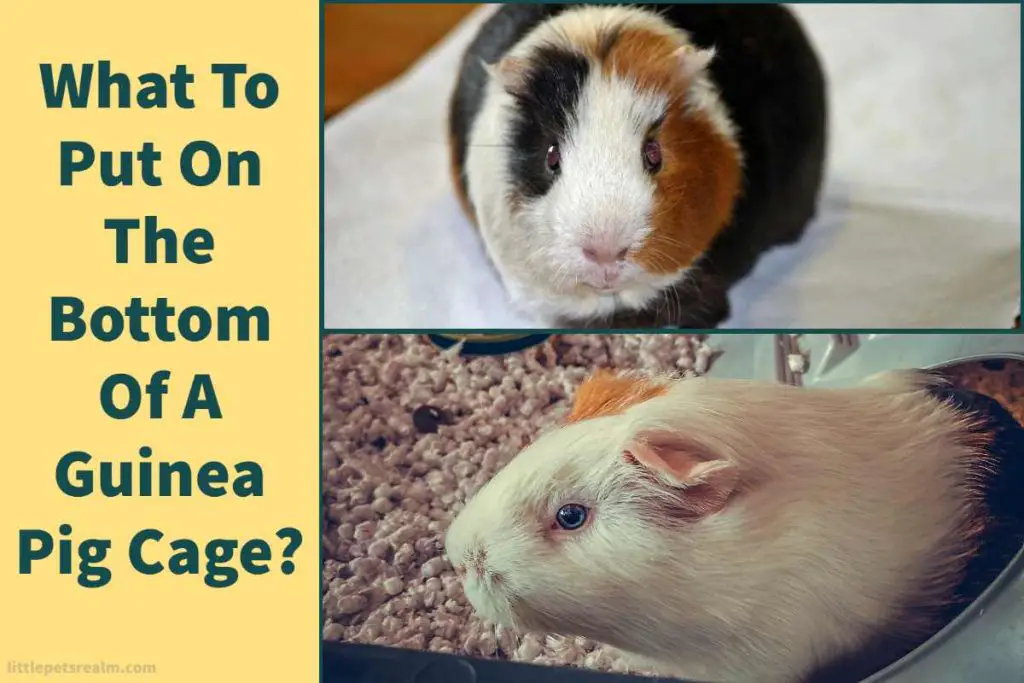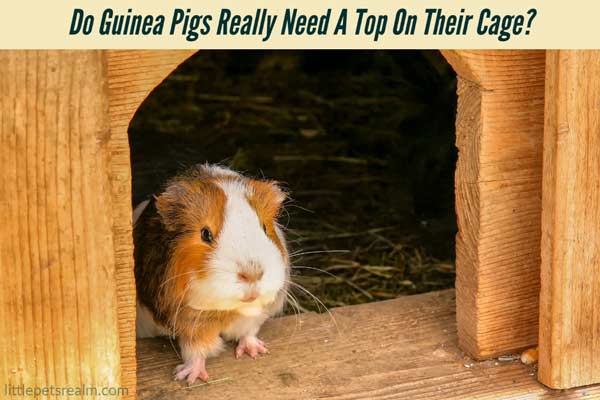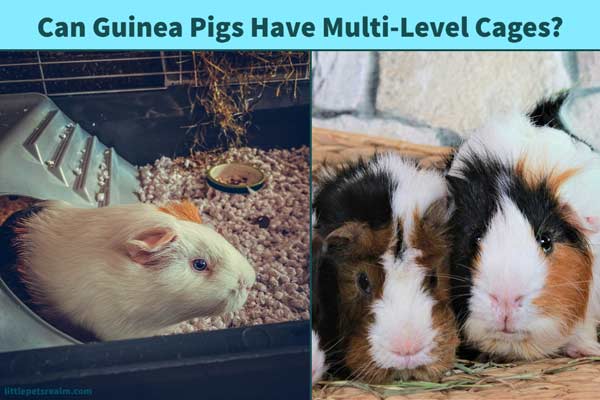After setting up a cage for your guinea pigs, your next concern is to set up the bottom of the cage and put essential things in it. So, you may wonder, What to put at the bottom of a guinea pig cage?
You have to put a proper liner, bedding, and absorbent material on the bottom of the guinea pig’s cage for making a clean, safe, and comfortable cage environment for them. Usually, coroplast, PVC canvas, or newspaper sheets are used as liners, and fleece, paper, or wood bedding are used on top of that.
However, you have to be careful of certain materials as they may not be healthy and safe for your guinea pigs.
You can also check out my other article on the best flooring ideas for guinea pigs.
In this article, you will get the ideas for the bottom of the guinea pig’s cage and know what to put on the bottom and what shouldn’t.
Table of Contents
Why do you need to put something on the bottom of your guinea pig’s cage?

Here are the causes of putting different things on the bottom of a guinea pig’s cage.
Making the smooth and well-gripped bottom
Guinea pigs need a surface that is flat and smooth and they can grip the surface as well. This helps them walk and run in the cage without any struggle. This is the major reason for which you need to put various things on the bottom.
Protecting sensitive feet
As guinea pigs have soft, small, and sensitive feet, you need to provide something on the bottom to protect those sweet paws. If it’s not good and safe for them, they will get ill.
Absorbing moisture
It’s hard to control moisture in a guinea pig cage as they can’t be litter-trained so easily. So, you have to ensure the bottom liners can control the moisture well.
Check out the best absorbent material for guinea pigs.
Comfort
Unlike other small pets, guinea pigs love too comfortable cage environment. So, it’s your duty to make the cage environment and bottom as comfortable as possible.
Controlling smell
Some materials develop a foul smell over time and make the room environment bad. So, use something on the bottom that can control this bad odor.
Maintaining hygiene
If you can’t maintain good hygiene, the guinea pig will get sick. So, cage bottom materials must be easy to clean and maintain hygiene.
Things to put on the bottom of guinea pig cage
You may wonder, what goes on at the bottom of a guinea pig cage? Let’s find out the things that you can put on the bottom of the cage.
1. Lining or flooring material
Most of the guinea pig’s cage is open at the bottom. So, you have to line the bottom of the cage with some things to provide support to the bedding materials and make the cleaning task easier.
Coroplast sheets
The best lining material for a guinea pig cage is coroplast sheet as it’s soft, easy to put on, and clean.
Check out another article on coroplast liners for the guinea pig.
You can get a coroplast liner separately or a cage such as Kavee c&c cage offers you this liner while you buy the cage.
Coroplast works great with all bedding. But, if you use fleece, you should use a coroplast liner.
Newspaper
You can also use a thick layer of newspaper sheets to line the floor. It can be a good option if you use wood shavings or paper pellets as bedding materials.
Newspaper sheets have a great absorbing capacity and help control moisture.
Using inkless papers is better if you see your guinea pig tearing up the newspaper and chewing them.
PVC canvas bottom
If you use a midwest guinea habitat, you have to use PVC canvas bottom. It’s durable and leak-proof. This product is hand washable and so easy to clean.
PVC canvas is usually chew-proof and safe to use for guinea pigs. You can put the bottom without any hurdle.
This liner is also available to buy separately. or, you should get a midwest guinea habitat.
Sheets of Linoleum
Similar to the coroplast sheet, you can choose linoleum for the bottom of the cage.
It’s easier to find and more affordable than a coroplast sheet.
You can customize the sheet easily by cutting it to the size and shape you want.
Sheets of linoleum are also much easier to clean and you don’t have to put in a lot of effort or time.
Plastic Tablecloths
It’s a good DIY guinea pig cage bottom. Choose a plastic tablecloth that is thick to use for the bottom of the cage.
You have to use a plain and plastic variety of the tablecloth as most of them are waterproof. It’s easy to clean and control the moisture.
An interesting fact about this item is its very affordable price and available everywhere in this world.
Actually, you may not have to buy this separately for your Guinea pigs if you have an old tablecloth that is intact.
If you feel it’s not enough you can use newspaper or linoleum with this to make the layer strong and thick.
Shower Curtain
In terms of availability, shower curtains are the best. You can get it anywhere at any time.
You can use your old shower curtain on the bottom of the cage after cleaning it nicely.
It’s also easy to handle, cut, and put on.
However, you need to use thick bedding material for this stuff so that the guinea pig may not eat it.
Waterproof mattress
A waterproof mattress can also be used as a DIY cage bottom to line the cage just like a tablecloth or a shower curtain.
However, you have to use their absorbent layer for this item.
2. Absorbent
You may need an absorbent layer in the bottom under the bedding materials separately if the bedding and liners can’t absorb moisture well.
Without it, the bottom of the cage will get wet and it will develop bacteria and mold. Moreover, a foul smell will be produced.
You can use a folded mattress pad, puppy pad, towels, or newspaper as an absorbent layer. Shredded paper can also help do that.
If you use a fleece liner that contains an absorbent layer such as Guinadad fleece, you won’t require extra absorbing material.
Mattress pads
Mattress pads can make a great absorbing layer for the bottom of the guinea pig cage. You can find this product easily in a local store at an affordable price.
These are made of washable cotton pads and work nicely to control moisture.
Towels
No other materials can be so easy to find as a towel. This is readily available at your home and very cheap.
Use some large towels and put them under the bottom of your Guinea pig’s cage.
It has a high absorbing property and you can wash and clean it easily as well.
Just make sure that you use some new towels or the old towels which are clean and have no scent on them.
Newspaper
Newspaper sheets that have the cheapest and easily available absorbing material for the bottom of the guinea pig cage.
Moreover, thick newspaper sheets under the bedding of the cage absorb moisture well and prevent the cage from getting wet.
In fact, it’s commonly used for this purpose. The shredded newspaper also works very great.
Puppy pads
You can also use puppy pads for controlling the moisture of the pee and poop.
It has a great absorbing property as this product is made to do so.
3. Bedding materials
After you put a liner and/or absorbent material in the bottom of the guinea pig cage, you must place bedding for them.
Guinea pig bodies are so delicate and their feet are so sensitive. So, you have to offer them an extra comfort.
Putting a soft and comfortable bedding material helps them live a healthy and happy life.
Good bedding material shouldn’t not only be soft and comfortable but also have great moisture and odor-controlling properties.
Here are examples of some good bedding to put in the bottom of a guinea pig’s cage.
Fleece bedding
Though fleece is a liner, it is used as bedding and is very popular among owners who have an indoor guinea pig.
Guinea pigs have a sensitive respiratory system and any bedding material isn’t safe for their health. But, fleece is good and safe for them as it doesn’t contain any dust or harmful chemicals.
Most importantly, it’s the softest and most comfortable bedding option available for them.
If you get a good product, it can also control moisture and odor well.
Some fleece may need an extra absorbent layer to put under it.
Our recommended product
GuineaDad Liner – Midwest Size, Blue | Guinea Pig Fleece Cage Liners
Also, check out the 9 best fleece bedding for guinea pigs.
Paper bedding
Natural paper bedding or recycled paper bedding that’s safe for a guinea pig is a great bedding material for an indoor cage. Paper bedding is the best in absorbency. It’s soft and can also control odor extremely well.
However, some bedding is dustier. So, make you the paper bedding is almost dust-free and doesn’t produce dust while using them.
Some people also make DIY paper bedding or use shredded paper. Make sure the paper you use is nontoxic for them and doesn’t contain any ink. These can be harmful to their health if they gnaw on the paper pellets.
Paper bedding is affordable in price and you can get it from anywhere in the world.
Check out the best paper bedding for guinea pigs.
Wood bedding
Wood bedding is also a great bedding material for guinea pigs. But, most commonly, it’s used for outdoor guinea pigs.
However, you can’t buy any kind of wood bedding for them. Kiln-dried pine, aspen, and hemp wood shavings are good bedding options for them.
These bedding materials have good absorbency and odor-controlling capacity. Most of them are also eco-friendly.
Though you have to replace shavings regularly, the product is reasonable in price and readily available in the market.
You have to ensure that this bedding doesn’t contain any dust and aromatic oils. These substances are dangerous for guinea pigs’ respiratory systems.
Check out the best wood bedding for guinea pigs.
Hay bedding
Hay is a good choice to put in the bottom of the cage as bedding material. They need hay every day to maintain their health. So, they will love this idea.
However, it’s not so absorbent and therefore you have to put absorbent materials under it. Try to use fresh, dried hay and not moldy hay.
Know more about hay bedding for guinea pigs.
4. Floor cover
If you use a cage on wheels you have to use a floor cover for your room floor under the cage.
This makes the cage sturdy and prevents stretch on the floor from the wheel.
You can use a mat or floor carpet under the cage for this.
5. Stand and storage
Many guinea pig owners use a stand under the cage. You can also consider using a stand because it helps keep the floor of your room clean.
Moreover, you can place storage bins or boxes underneath the cage to store your guinea pig supplies.
Best ideas for the bottom of the guinea pig cage
Let’s know what to use for the different bottoms of guinea pig cages.
1. Plastic bottom
Put some newspaper sheets on the bottom and make a thick layer. Then, use paper or wood bedding to cover the newspaper completely.
Newspaper is important for absorption and preventing the sliding-out movement of the bedding.
You can also use fleece bedding for this type of bottom. But, it may slide out more when your piggies move.
Our recommended product
Midlee Corrugated Plastic Cage Liner
2. Canvas bottom
Use fleece bedding for the bottom as it works the best with it. You don’t need to use another liner if you use midwest PVC bottom.
Our recommended product
Canvas Bottom for Guinea Pig Habitat
3. Wire bottom
Though the wire bottom cage is not good for guinea pigs you may have to use it if you build a multi-level cage. In that case, you have to cover it properly to prevent your guinea pigs from getting trapped in the cage hole.
Put coroplast liner and thick bedding on the bottom.
You can use fleece for this bottom.
However, you can also use wood or paper bedding with this.
4. Wood bottom
Use kiln-dried pine or aspen wood shavings for the wood bottom as they complement it.
It’s also appropriate because wooden hutches are placed outside.
Use newspaper sheets to line the bottom of this type of hutches.
5. Slide-out bottom
The sliding-out bottom allows the floor waste to pass through the wire bottom, you cannot give it exposed for the safety of your guinea pig.
Put bedding material such as wood shavings or natural paper pellets and a liner such as newspaper under it.
You may also want to know, what to put on the removable tray under the wire bottom of the guinea pig’s cage?
Mostly you don’t need to put anything under the bottom of the cage, as it’s made to catch guinea pig waste.
However, you can use an absorbent material such as wood shavings in it to absorb the liquid.
Clay litter can also be used as you do for cat litter.
But it’s better not to use this kind of wire bottom cage for the guinea pig to keep them safe.
Table: Best guinea pig cage bottom ideas
| Cage types | Bottom Ideas |
| Plastic bottom | Newspaper sheets and Natural paper/Aspen wood bedding |
| Canvas bottom | PVC canvas bottom and Fleece bedding |
| Slide-out bottom | Newspaper sheets and Fleece bedding |
| Wire bottom | Coroplast liner and Fleece/Kiln-dried pine/Aspen bedding |
| Wood bottom | Newspaper sheets and Kiln-dried pine/Aspen bedding |
Things not to put on the bottom of the guinea pig cage
You can’t put many things on the bottom of the guinea pig’s cage as you can do in the case of other small pets. Here are the things that you should avoid.
Unsafe wood shavings
Cedar and non-kiln-dried pine shavings are dangerous for guinea pigs’ health because of their aromatic oils and scent.
These can lead to severe respiratory tract problems and even death. You can’t even put sawdust on the bottom of the floor due to the high amount of dust.
Raw straw
Raw straw is so hard and stiff. It can splinter and injure your guinea pigs seriously. Moreover, it is not can’t absorb moisture and therefore produce a bad odor.
Unhealthy paper pellets
Stay away from paper pellets or shredded paper that contains ink, dye, and other harmful chemicals. Moreover, paper bedding must be dust-free so that it can’t cause any breathing problems.
Takeaways
Whatever you use in the bottom of the guinea pig cage make sure that it’s hygienic, easy to clean, safe, and comfortable for guinea pigs.
Put lining materials on the bottom and cover it with suitable bedding materials. Use an absorbent material in between both of those layers to control moisture, if it’s necessary.






